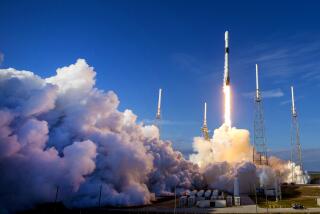SpaceX test-fires its Falcon Heavy rocket; launch expected ‘in a week or so’

A new space race is afoot. Leading the pack is the Falcon Heavy, The most powerful rocket yet from SpaceX.
- Share via
SpaceX performed a static fire of its long-awaited Falcon Heavy rocket Wednesday at Kennedy Space Center in Florida, and Chief Executive Elon Musk expects the rocket to launch in about a week.
Around 9:30 a.m. Pacific Time, large plumes of steam began to billow out from what appeared to be the base of the massive rocket, followed by a low rumbling noise, as seen and heard on a Periscope live stream of the test site by Chris Gebhardt, assistant managing editor at space news site NASAspaceflight.com.
“Falcon Heavy hold-down firing this morning was good,” Musk said on Twitter.
The hold-down test fire, which is intended to evaluate the Falcon Heavy’s 27 engines, was not live streamed by either SpaceX or NASA. They do not typically broadcast such tests.
On the Periscope live stream Wednesday, recorded from a spot about 4 miles away from the launch pad, onlookers could be heard cheering after the rumbling subsided.
The Falcon Heavy test fire was expected to take place earlier this month but was delayed, in part by the recent federal government shutdown.
The 45th Space Wing, a U.S. Air Force unit stationed at Patrick Air Force Base in Florida, said in a statement earlier this week that “due to the shutdown removing key members of the civilian workforce,” it would not be able to support commercial static fires at Kennedy Space Center. The 45th Space Wing said it also would be unable to support launch operations without its civilian workforce.
SpaceX spokesman John Taylor confirmed Monday that the shutdown would affect the Falcon Heavy demonstration launch.
Government offices reopened Tuesday.
The Falcon Heavy rocket is expected to help SpaceX — which is based in Hawthorne and whose full name is Space Exploration Technologies Corp. — win more national security missions, as well as commercial launches that require more power than SpaceX’s Falcon 9 rocket can produce.
Falcon Heavy is composed of three engine cores. After launch, SpaceX will attempt to land all three of the boosters — two on land and one on a floating droneship.
Twitter: @smasunaga
More to Read
Inside the business of entertainment
The Wide Shot brings you news, analysis and insights on everything from streaming wars to production — and what it all means for the future.
You may occasionally receive promotional content from the Los Angeles Times.











